Books of Prime Entry | Accountancy - Approaches of recording transactions | 11th Accountancy : Chapter 3 : Books of Prime Entry
Chapter: 11th Accountancy : Chapter 3 : Books of Prime Entry
Approaches of recording transactions
Approaches of recording transactions
There are two
approaches for recording transactions, namely, i) Accounting equation approach
and ii) Traditional approach.
1. Accounting equation approach
The
relationship of assets with that of liabilities to outsiders and to owners in
the equation form is known as accounting equation.
Under the
double entry system of book keeping, every transaction has two fold effect,
which causes the changes in assets and liabilities or capital in such a way
that an accounting equation is completed and equated.
Capital +
Liabilities = Assets
Capital can
also be called as owner’s equity and liabilities as outsider’s equity.
Accounting equation is a mathematical expression which shows that the total of assets is equal to the total of liabilities and capital. This is based on the dual aspect concept of accounting. This means that total claims of outsiders and the proprietor against a business enterprise will always be equal to the total assets of the business enterprise
As the revenues and expenses will affect capital, the expanded equation may be given as under:
Assets =
Liabilities + Capital + Revenues – Expenses
Therefore,
under this approach, accounts are classified into five categories: (i) Asset
account, (ii)
Liability account, (iii) Capital account, (iv)
Revenue account and (v) Expense account as follows:

i. Asset account
Any physical
thing or right owned that has a monetary value is called asset. The assets are
grouped and shown separately; for example, Land and Buildings account, Plant
and Machinery account.
ii. Liability account
Financial obligations of the enterprise towards
outsiders are shown under separate heads as liabilities; for example, creditors
account, expenses outstanding account.
iii. Capital account
Financial obligations of a business enterprise
towards its owners are grouped under this category; for example, capital
contributed by owner.
iv. Revenue account
Accounts
relating to revenues of an enterprise are grouped under this category, for
example; revenues from sale of goods, rent received.
v. Expense account
Expenses
incurred and losses suffered for earning revenue are grouped under this
category; for example, purchase of goods, salaries paid.
A transaction
may have the effect on either side of the equation by the same amount or it may
have the effect on one side of the equation only, by both increasing and
decreasing it by an equal amount.
Recording of
transactions as per accounting equation approach is explained below:
(a) Increase in capital and increase in asset
Commenced business with cash Rs. 1,00,000
Effects:
(i) Cash comes in → Increase in asset
(ii) Capital
provided by the owner → Increase in capital of owner
Capital =
Assets
Capital = Cash
(+) Rs. 1, 00,000 = (+) Rs. 1,
00,000
(b) Decrease in liability and decrease in asset
Paid creditors Rs. 10,000
Effects: (i)
Cash goes out → Decrease in asset
Creditors are
paid → Decrease in liability
Liabilities =
Assets
Creditors = Cash
(–) Rs. 10,000 = (–) Rs. 10,000
(c) Decrease in one asset and increase in another asset
Bought furniture costing Rs. 5,000 by
paying cash
Effects:
(i) Furniture comes in → Increase in asset
(ii) Cash goes out → Decrease in asset
Liabilities = Assets
Liabilities = Cash + Furniture
= (–) Rs. 5,000
(+) Rs. 5,000
(d) Decrease in one liability and increase in another liability
Accepted a bill drawn by creditors for Rs. 20,000
Effects:
(i) Bills payable arises → Increase in liability
(ii) Reduction in creditors → Decrease in liability
Liabilities = Assets
+ Bills payable – Creditors = Assets
(+) Rs.
10,000 (–) Rs. 10,000 = Assets
(e) Transactions affecting more than two accounts:
Goods costing Rs. 30,000
sold for Rs. 40,000
Effects:
(i) Goods go out → Decrease in assets
Cash comes in → Increase in assets
Sold goods at a profit → Increase in capital
Liabilities +
Capital = Assets
Capital = Cash
– Stock
(+) Rs.
10,000 =
(+) Rs. 40,000 (–) Rs. 30,000
Illustration 1
Complete the missing items.

Illustration 2
Show the
accounting equation on the basis of the following transactions for Rani, who is
dealing in automobiles.
(i) Started business with cash 80,000
(ii) Goods bought on credit from Ramesh Rs. 10,000
(iii) Purchased furniture for cash Rs. 6,000
(iv) Paid creditors by cash Rs. 8,000
Solution
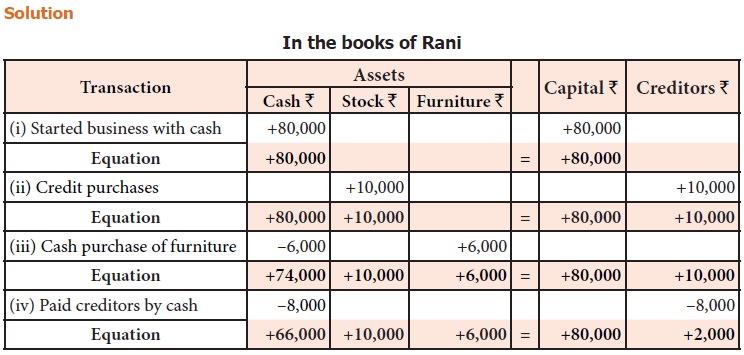
Illustration 3
Show the accounting equation on the basis of the
following:
(a) Started business with cash 60,000
(b) Purchased goods for cash Rs. 20,000
(c) Sold goods for cash costing Rs. 10,000 for Rs. 15,000
(d) Paid rent by cash :
: Rs. 500
Solution
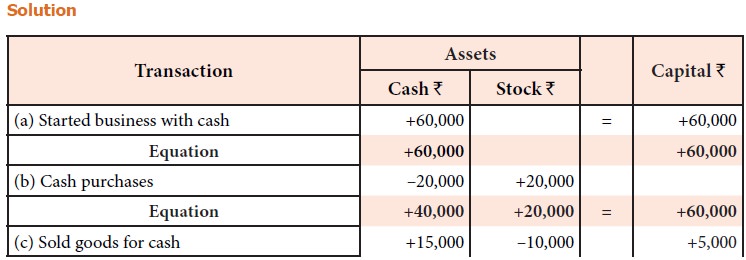

Illustration 4
Selvi is a dealer in furniture. Show the accounting
equation for the following transactions.
(i) Started business with cash Rs. 1,00,000
(ii) Deposited cash into bank Rs. 60,000
(iii) Borrowed loan from bank Rs. 25,000
(iv) Bought goods and paid by cheque Rs. 10,000
(v) Cash withdrawn for personal use Rs. 5,000
(vi) Cash withdrawn from bank for office use Rs. 3,000
Solution
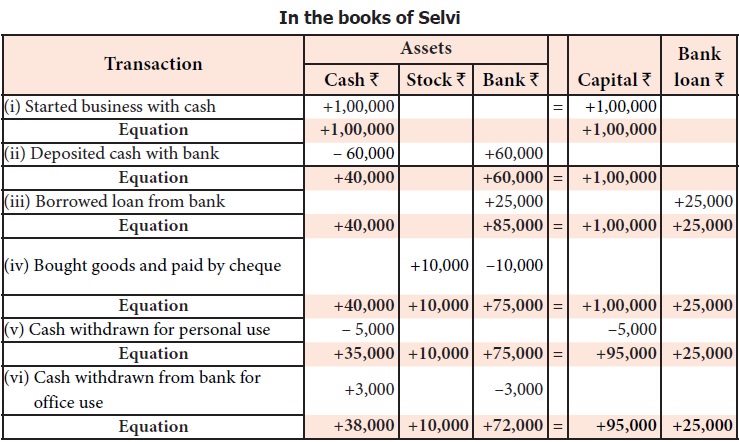
Illustration 5
Show the effect of following business transactions
on the accounting equation.
(i) Anbu started business with cash Rs. 20,000;
goods Rs. 12,000 and machine Rs.
8,000
(ii) Purchased goods from Ramani on credit Rs. 7,000
(iii) Payment made to Ramani in full settlement Rs. 6,900
(iv) Sold goods to Rajan on credit costing Rs.
5,400 for Rs. 6,000
Received from
Rajan Rs. 5,800 in full settlement of his account
(vi) Wages outstanding Rs. 400
Solution
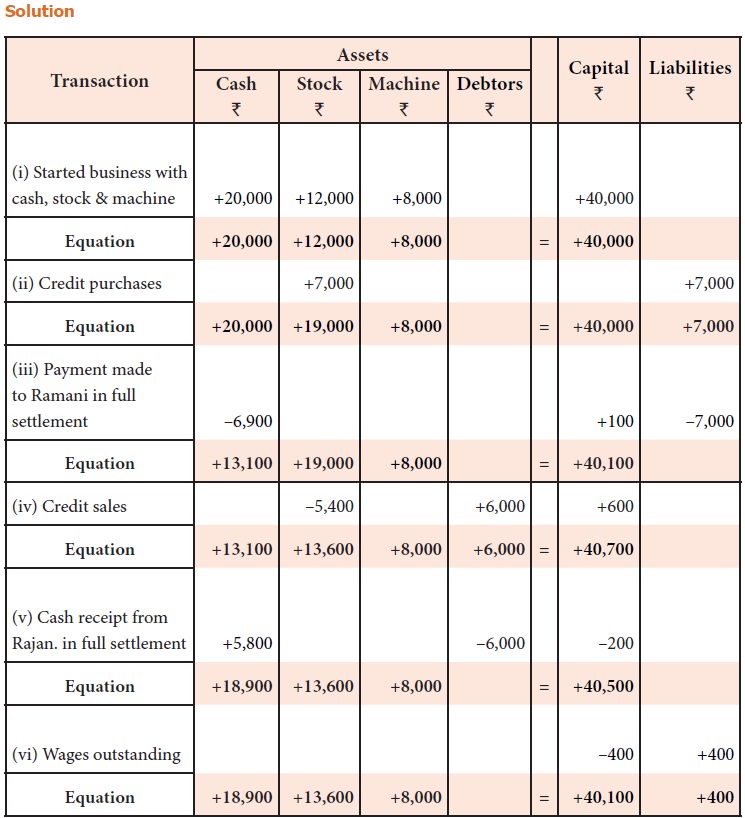
Illustration 6
Veena is a dealer in textiles. On January 1, 2018,
her business showed the following balances: Cash in hand: Rs. 20,000; Bank balance: Rs. 70,000;
Stock: Rs. 15,000. Following are the transactions made during
January 2018. Show the effect of the transactions on accounting equation.
(a) Purchased
goods (readymade shirts) on credit from Subbu Rs.
20,000
(b) Goods
returned to Subbu and no cash is received Rs.
5,000
(c) Goods
(shirts) costing Rs. 1,600 was sold to Janani on credit Rs. 2,000
(d) Janani
returned 1 shirt of sales value Rs. 500
(e) Janani
deposited the money due in cash deposit machine in a bank Rs. 1,500
(f) Insurance
on building paid through net banking Rs.
1,000
(g) Of the
insurance paid, prepaid during the year is Rs.
100
Solution
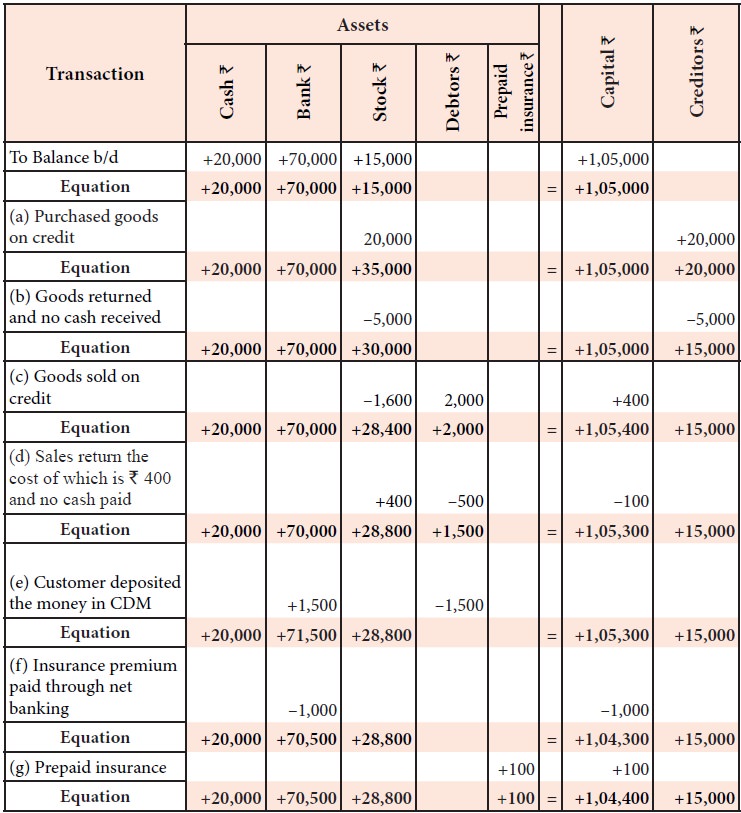
2. Traditional approach
Under this
approach, the two fold aspects (debit and credit) in each transaction are
recorded in the journal by following double entry system. For the purpose of
recording the transactions, accounts are classified into personal and
impersonal accounts.
1. Classification of accounts:
Under double
entry system of book keeping, for the purpose of recording the various
financial transactions, the accounts are classified as personal accounts and
impersonal accounts.

i. Personal account: Account relating to
persons is called personal account. The personal account may be natural,
artificial or representative personal account.
·
Natural
person’s account: Natural person means human beings. Example: Vinoth account,
Malini account.
·
Artificial
person’s account: Artificial person refers to the persons other than human
beings recognised by law as persons. They include business concerns, charitable
institutions, etc. Example: BHEL account, Bank account.
·
Representative
personal accounts: These are the accounts which represent
personsnatural or artificial or a group of persons. Example: Outstanding salaries
account, Prepaid rent account. When expenses are outstanding, it is payable to
a person. Hence, it represents a person.![]()
ii. Impersonal accounts: All accounts which do not
affect persons are called impersonal accounts. These are further classified into a)
Real accounts and b) Nominal accounts.
a. Real account: All accounts
relating to tangible and intangible properties and possessions are called real
accounts.
·
Tangible
real accounts: These include accounts of properties and possessions which can be seen and
touched. These have physical existence. Example: Plant, Machinery, Building,
Furniture, Stock.
·
Intangible
real accounts: These include
accounts of properties and possessions which can not be seen and touched. These do
not have physical existence. Example: Goodwill, Patents, Copy rights.
b. Nominal account: The accounts
relating to expenses, losses, revenues and gains are
called nominal accounts. Example: Salaries, wages, rental income,
interest income, etc. These are temporary accounts and are transferred to
Trading and Profit and Loss account depending on whether these are direct or
indirect respectively.

Related Topics